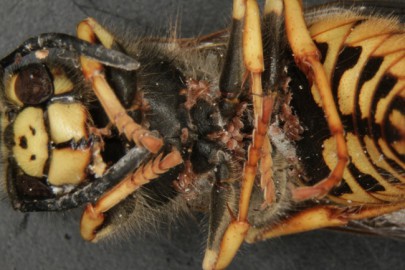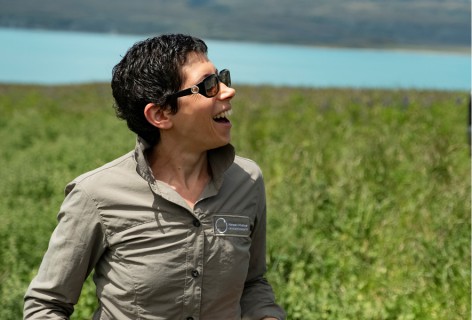Wasp biocontrol update 2
In this section
An update on the project investigating the biocontrol potential of promising-looking mites that were recently discovered and that appear to attack wasps.

Wasp with mite infestation
An update on the project investigating the biocontrol potential of promising-looking mites that were recently discovered and that appear to attack wasps.
In the previous update we told you about the application we made to the Environmental Protection Authority (EPA) to determine the legal status of the wasp mite. A few days ago we received a nice Christmas gift in the form of a decision by the EPA determining that, for the purpose of the HSNO Act, the mite is a non-new organism. This doesn’t mean we have any better knowledge about when and where from the mite came to New Zealand or if it is native. It does however mean that when the time comes that we are ready to mass rear and distribute the mite, it will be legal for us to do so. For that time to come we still need to learn a lot about the biology and safety of the mite.
Summer is hopefully not too far off, and that means wasp numbers are starting to build up. You may see fewer queens buzzing around than a month or so ago. That is because queens have by now found nesting sites and are now attending their first brood. It won’t be long before workers will start humming around. If you start noticing nest activity, please let us know if any such nests are located where we could reach to sample them. Over the coming months from late January Bob will begin sampling nests to figure out how widespread the mites are.
During each of the 3 years of the project we intend to survey three regions for mite prevalence. First off this summer will be Canterbury, Nelson Lakes, and possibly other areas in the Top of the South. Land-owners in these regions – if you are willing to locate nests and let Bob come to dig them out later on, we will appreciate it!
Land owners in other regions – if you feel safe enough to dig and freeze nests – we would appreciate any contribution! But only if you are confident you can perform this activity safely!
Until the next update – wishing you all a relaxing Christmas and a stingless New Year!
Non-new organism status: context to EPA’s decision
The HSNO Act 1996 regulates hazardous substances and new organisms in New Zealand. For the purpose of the Act, organisms that were not in New Zealand prior to 29/07/1998 are considered new organisms and require approval to be brought into the country and are not allowed to be propagated and/or distributed intentionally. We took on the task to convince EPA that, although the wasp mite is a new organism to science and was not discovered anywhere in the world prior to being found by Bob here in New Zealand, it should nevertheless be treated as a non-new organism for the purpose of the HSNO Act. We wanted to convince EPA that the mite has likely been here for some time, but has gone unnoticed.
Why did we think the mite has already been here for a number of years?
Following Bob’s discovery of the mite in 2011, we were able to find evidence going as far back as 2003 that the mite was present on the North and South Islands of New Zealand and went undetected. While the clear evidence doesn’t go further back than 2003, it was strong enough to suggest that the mite was here several years earlier.
You may ask yourself: If the mite was already here that long, has it not had long enough to show off its biocontrol potential?
Well, you have to remember that natural dispersal rates of mites are slow. It often takes many years for insects and mites to build up dense populations - they may need a helping hand to get further quicker. They may do better when a wasp nest is already compromised for other reasons, in which case we may have to find a way to stress nests in preparation for mite take-over. On the other hand, we may discover that the mite is already as far as it will ever get and as damaging as it will ever get which is, simply put, not enough. There are still a myriad of un-answered questions about the mite. Let us hope that the mite has not yet had a chance to demonstrate its full potential, and that we are en route to utilise it!

